Canon EF-S 15-85 mm f/3.5-5.6 IS USM
3. Build quality and image stabilization
EF-S 15-85 mm begins with a metal bayonet, from which a rubber ring protrudes, so characteristic of EF-S mount, which makes it impossible to mount the lens on full frame camera bodies. This is a relic of the times when Canon was the only manufacturer with a full frame DSLR and could set the rules, without really having to bother with the competition. Now this relic is backfiring on it, as it’s the only manufacturer on the market with lenses that can’t be mounted on their own DSLRs.
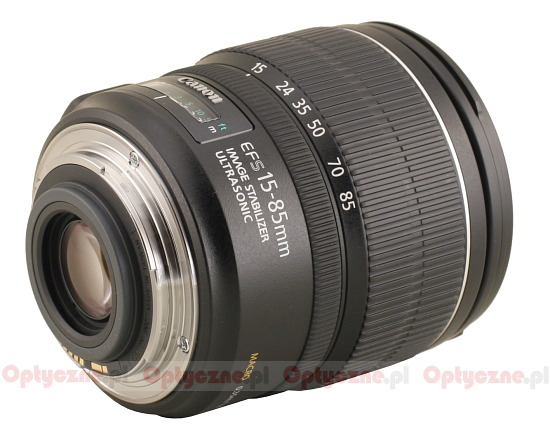 |
Please Support UsIf you enjoy our reviews and articles, and you want us to continue our work please, support our website by donating through PayPal. The funds are going to be used for paying our editorial team, renting servers, and equipping our testing studio; only that way we will be able to continue providing you interesting content for free. |
- - - - - - - - - - - - - - - - - - - - - - - - - - - - - - - - - - - - - - - - - - - - - - - -
The bayonet with the rubber ring, at whose side there’s a “Made in Taiwan” inscription surrounds the rear lens of 22 mm diameter, which at 15 mm is almost even with the bayonet and at 85 mm hides 3 cm into the lens body.
Right behind the bayonet, there’s a legible distance scale place behind a pane of glass and express in both feet and meters. On the left side there’s a focusing mode switch (AF/MF) and a stabilization mode switch (STABILIZER ON/OFF). Going further we find a narrow, if we take into account the size of the lens, ring for manual focusing. It’s made of rubber and it’s corrugated. Unfortunately, it’s hard to say about a high comfort when using it, even more so, because it’s hidden slightly deeper in the body than the large ring for zooming, which is placed right next to it. So it happens that we often have problems with quick finding the focusing ring, with our fingers.
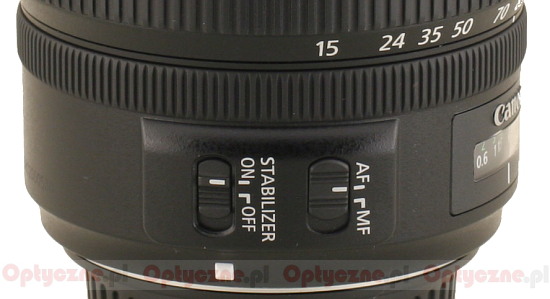 |
The ring for zooming, on the other hand, is very wide and convenient to hold. Unfortunately, it doesn’t work equally. It gives lots of resistance in 15-30 mm and 60-85 mm ranges, and noticeable slack in between. It’s large enough to make the lens extend under its own weight for focal lengths 30-60 mm.
Making the focal length larger we cause the size of the lens to increase. The smallest size of about 10 cm is obtained at 15 mm. Together with increasing the focal length, the front system of lenses extends on a telescopic (looking plastic) barrel, making the overall size increase to almost 14 centimeters.
The front lens is quite large, as it has the diameter of 55 mm and it’s surrounded by a non-rotating filter thread of 72 mm.
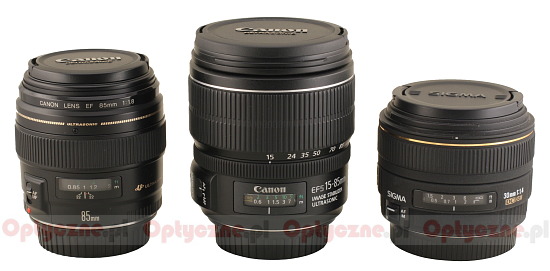 |
Let’s have another look at the comparison between the tested lens to its predecessor and rivals, which is presented in this table. You can immediately see that the new EF-S model is the heaviest lens and that’s with the competing Nikkor also having image stabilization and as many optical elements.
If we’re at the optics, it’s worth to mention that we have 17 elements set in 12 groups, here, among which we’ll find three aspherical lenses and one made of low-dispersion UD glass. Inside the lens there’s also a circular diaphragm of seven blades, which depending on the focal length can be closed down to f/22 or f/36.

A buyer gets only both caps supplied in the box. Unfortunately, even when spending around 720 $ we won’t receive Canon’s lens hood. We need to buy it separately.
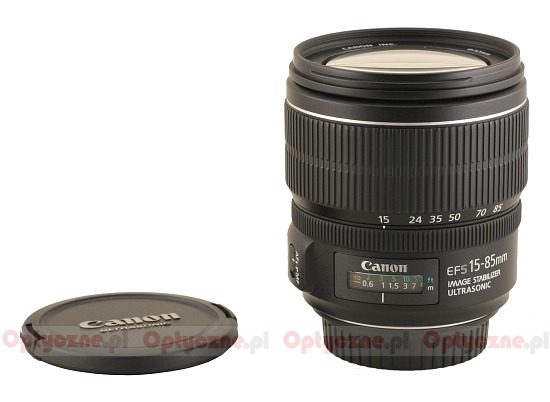 |
Image stabilization
Canon boasts that in the case of Canon 15-85 mm they used a new generation image stabilization, which supposedly gives efficiency of 4 EV. We’ve decided to test it by taking pictures at 85 mm with different exposure times and comparing the number of blurred pictures both for the stabilization on and off. The corresponding graph is presented below. The shutter time is expressed in exposure values and in this case 0 EV means 1/125 second.
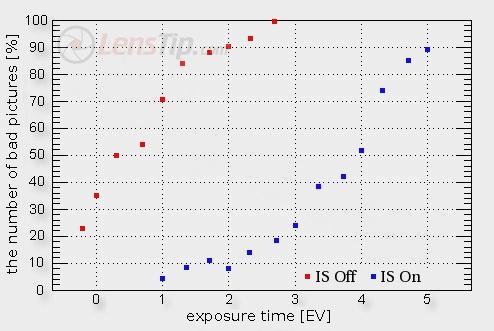
You can distinctly see that the image stabilization in the tested Canon lens is really efficient. There’s still something missing to the promised 4 EV, but we can definitely say about the results of 3.5 EV. We can praise Canon here, as it’s difficult to find a device, a lens or a camera, which in this category performs better.






